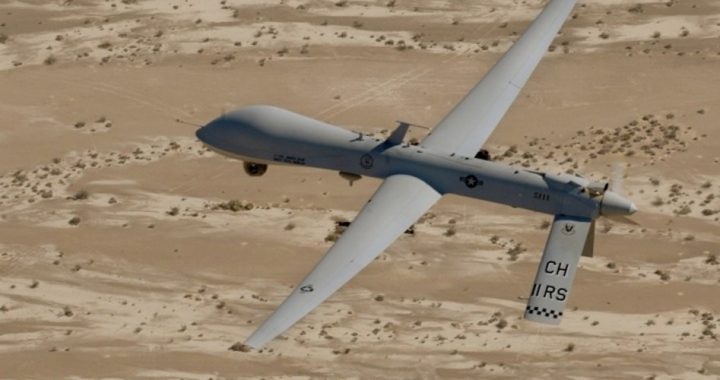
The Associated Press (AP), quoting Yemeni security officials, reports that a drone believed to be American fired missiles at two cars late Thursday morning, October 4, in Yemen. The officials quoted in the AP story report that “at least five” people were killed, all of whom were traveling in one of the two cars targeted by the drone.
Other accounts of the attack say four people were killed. Apparently, no tally of the casualties from the other vehicle was taken.
Shabwa province, the site of the attack, is described by the AP as “one of several Yemeni provinces were al-Qaida has concentrated.”
Agence France-Press (AFP), quoting local tribal chief Abdulmajid al-Awlaqi, reports that the five men killed by the missile strike were “militants,” members of a group called Ansar Al-Sharia (Partisans of Islamic Law).
This pretext for the killings brings up the question: When did militancy become a crime? If it is a crime, moreover, where is it defined? How can anyone know if he is guilty of militancy if such a crime is not defined? Could one hypothetically be a militant without knowing it, given that the crime is nowhere defined?
Furthermore, is the suspicion that one is associated with a group believed to be capable of planning attacks on American allies sufficient justification for the immediate execution of that person?
Awlaqi also identifies two of the men killed as members of his tribe and one of the other fatalities as “an Egyptian.”
According to AFP, witnesses on the ground reported seeing four missiles fired from the drone as the two vehicles passed through the town of Saeed.
Saeed is the town known as the “ancestral homeland” of Anwar al-Awlaki and his son Abdulrahman al-Awlaki — American citizens killed in the Obama administration’s death-by-drone program that targets and eliminates those people whose names appear on the president’s infamous “kill list.” Notably, neither man was ever accused of a crime and the U.S. government never attempted to capture either of them. Both men — Abdulrahman was only 15 when he was killed — were summarily executed without due process.
Of course, that could be because he might actually have ended up in a court of law if he had been apprehended; and President Obama, a former lawyer, knows that trials can be long, messy, and unpredictable. It is much quicker and cleaner to fire missiles than to go through the hassle of due process.
After Thursday morning’s attack in Saeed, AFP quotes a local resident who reported, “The two cars are still burning and we couldn’t get close to them because the drones are still hovering in the area.”
This information sounds eerily similar to the “double-tap” drone strikes that are becoming a regular feature of the United States’ drone war in Pakistan.
The Daily Mail (UK) describes the tactic: “A drone fires one missile — and then a second as rescuers try to drag victims from the rubble. One aid agency said they had a six-hour delay before going to the scene.” According to the story this insupportable and inhumane tactic is resulting in the death of “49 people for every one known terrorist in Pakistan.”
Although U.S. officials typically do not comment on this or any other drone strike in Yemen or elsewhere, the president of Yemen isn’t quite so close-mouthed about the arrangement between the two “allies.”
In a statement made to the Washington Post in an interview published September 29, President Abed Rabbo Mansour Hadi said he “personally approves every U.S. drone strike in his country.”
Hadi’s praise for the Predators continued during a speech delivered at the Woodrow Wilson International Center for Scholars. “They [drones] pinpoint the target and have zero margin of error, if you know what target you’re aiming at,” Hadi said, according to the New York Times.
As the Washington Post rightly posits, it is likely this personal interest in promoting President Obama’s drone war that has influenced U.S. officials to consider Hadi “one of the United States’ staunchest counterterrorism allies.”
In an article published October 4, the online Long War Journal, a reliable reporter of the drone war’s size and scope, describes the attacks in the Yemen:
The US is known to have carried out 33 airstrikes against AQAP [al-Qaeda in the Arab Peninsula] in Yemen so far this year: one in January, six in March, six more in April, nine in May, two in June, one in July, five in August, two in September, and one so far this month. Other recent airstrikes are believed to have been carried out by the US also, but little evidence has emerged to directly link the attacks to the US.
Since December 2009, the CIA and the US military’s Joint Special Operations Command are known to have conducted at least 47 air and missile strikes inside Yemen, including today’s [Thursday’s] strike.
Long War Journal also indicates that over the last year and a half, “the pace of the US airstrikes increased” in Yemen. Perhaps soon citizens of this small Arab nation will be traumatized by the constant buzzing of U.S. drones as is already the case in Pakistan.
In a recent report on the drone war in Pakistan written by New York University and Stanford University, the authors relate the story of two-time Pulitzer Prize winning reporter David Rohde who was kidnapped in November 2008 and held for seven months by the Taliban while covering Afghanistan and Pakistan for the New York Times in the Federally Administered Tribal Areas (FATA) of northwest Pakistan. Rohde’s story as quoted in the drone report: “The drones were terrifying. From the ground, it is impossible to determine who or what they are tracking as they circle overhead. The buzz of a distant propeller is a constant reminder of imminent death.”
Describing the experience of living under drones as “hell on earth,” Rohde explained that even in the areas where strikes were less frequent, the people living there still feared for their lives.
Many in the United States may discount the importance of such a story, pointing out that such an existence is the price of harboring terrorists and those intent on threatening the national security of the United States.
One wonders if that attitude will change in the next couple of years when 30,000 drones fill the skies of the United States. Will we come to know the ever-present sound of a “distant propeller” stirring up the otherwise placid domestic skies with the inimitable buzz of imminent death? Will we live in constant fear of “when is the next drone attack going to happen” as one mental health professional hears daily from the men and women of Waziristan?
No report on the drone attack in Yemen has indicated who may have been the intended target of the strike. Even if such a disclosure is eventually made, it will likely not include “due process” as one of the casualties.
Photo of Predator drone: AP Images



